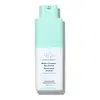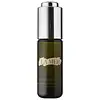What's inside
What's inside
 Key Ingredients
Key Ingredients

 Benefits
Benefits

 Concerns
Concerns

 Ingredients Side-by-side
Ingredients Side-by-side

Water
Skin ConditioningOctyldodecanol
EmollientGlycerin
HumectantBoron Nitride
AbsorbentSaccharomyces/Xylinum/Black Tea Ferment
Skin ConditioningCoconut Alkanes
EmollientCetyl Alcohol
EmollientCetearyl Olivate
Sorbitan Olivate
EmulsifyingNiacinamide
SmoothingCopper Tripeptide-1
Skin ConditioningLeontopodium Alpinum Meristem Cell Culture
Skin ConditioningDipeptide-2
Skin ConditioningPalmitoyl Tripeptide-1
Skin ConditioningPalmitoyl Tetrapeptide-7
Skin ConditioningCopper Lysinate/Prolinate
Skin ConditioningHesperidin Methyl Chalcone
AntioxidantChondrus Crispus
MaskingMangifera Indica Seed Butter
Skin ConditioningGlycine Soja Oil
EmollientHippophae Rhamnoides Oil
EmollientSclerocarya Birrea Seed Oil
HumectantSodium Hyaluronate Crosspolymer
HumectantHydroxyethylcellulose
Emulsion StabilisingCoco-Caprylate/Caprate
EmollientSteareth-20
CleansingLecithin
EmollientPanthenol
Skin ConditioningN-Hydroxysuccinimide
Skin ConditioningUbiquinone
AntioxidantCitric Acid
BufferingThioctic Acid
AntioxidantTocopherol
AntioxidantChrysin
Skin ConditioningSclerotium Gum
Emulsion StabilisingMethylglucoside Phosphate
Skin ConditioningXanthan Gum
EmulsifyingPotassium Sorbate
PreservativeSodium Benzoate
MaskingChlorphenesin
AntimicrobialCaprylyl Glycol
EmollientSodium Hydroxide
BufferingPhenoxyethanol
PreservativePentylene Glycol
Skin ConditioningWater, Octyldodecanol, Glycerin, Boron Nitride, Saccharomyces/Xylinum/Black Tea Ferment, Coconut Alkanes, Cetyl Alcohol, Cetearyl Olivate, Sorbitan Olivate, Niacinamide, Copper Tripeptide-1, Leontopodium Alpinum Meristem Cell Culture, Dipeptide-2, Palmitoyl Tripeptide-1, Palmitoyl Tetrapeptide-7, Copper Lysinate/Prolinate, Hesperidin Methyl Chalcone, Chondrus Crispus, Mangifera Indica Seed Butter, Glycine Soja Oil, Hippophae Rhamnoides Oil, Sclerocarya Birrea Seed Oil, Sodium Hyaluronate Crosspolymer, Hydroxyethylcellulose, Coco-Caprylate/Caprate, Steareth-20, Lecithin, Panthenol, N-Hydroxysuccinimide, Ubiquinone, Citric Acid, Thioctic Acid, Tocopherol, Chrysin, Sclerotium Gum, Methylglucoside Phosphate, Xanthan Gum, Potassium Sorbate, Sodium Benzoate, Chlorphenesin, Caprylyl Glycol, Sodium Hydroxide, Phenoxyethanol, Pentylene Glycol
Water
Skin ConditioningPropanediol
SolventAlgae Extract
EmollientGlycerin
HumectantPrunus Amygdalus Dulcis Seed Extract
Skin ConditioningSesamum Indicum Seed Oil
EmollientMedicago Sativa Seed Powder
Skin ConditioningHelianthus Annuus Seedcake
AbrasivePrunus Amygdalus Dulcis Seed Meal
AbrasiveEucalyptus Globulus Leaf Oil
PerfumingSodium Gluconate
Skin ConditioningCopper Gluconate
Skin ConditioningMagnesium Gluconate
Skin ConditioningCalcium Gluconate
HumectantZinc Gluconate
Skin ConditioningTocopheryl Succinate
AntioxidantNiacin
SmoothingSesamum Indicum Seed Powder
Skin ConditioningSucrose
HumectantPyrus Malus Fruit Extract
Skin ConditioningCitrullus Lanatus Fruit Extract
Skin ConditioningPorphyridium Cruentum Extract
Skin ConditioningLens Esculenta Fruit Extract
Skin ConditioningLaminaria Digitata Extract
Skin ProtectingSaccharomyces Lysate Extract
HumectantAscophyllum Nodosum Extract
Skin ConditioningPlankton Extract
Skin ConditioningCitrus Aurantifolia Peel Extract
CleansingTourmaline
Sigesbeckia Orientalis Extract
Skin ConditioningAsparagopsis Armata Extract
Skin ProtectingAcetyl Hexapeptide-8
HumectantCaffeine
Skin ConditioningPullulan
Trehalose
HumectantSodium Lactate
BufferingSorbitol
HumectantSodium PCA
HumectantStyrene/Vp Copolymer
Hydroxypropyl Methylcellulose
Emulsion StabilisingSodium Hyaluronate
HumectantHexylene Glycol
EmulsifyingButylene Glycol
HumectantVinyl Dimethicone/Methicone Silsesquioxane Crosspolymer
Alcohol Denat.
AntimicrobialXanthan Gum
EmulsifyingIsododecane
EmollientEthylhexylglycerin
Skin ConditioningCaprylyl Glycol
EmollientTrimethylsiloxysilicate
EmollientParfum
MaskingDisodium EDTA
Phenoxyethanol
PreservativePotassium Sorbate
PreservativeSodium Benzoate
MaskingCI 61570
Cosmetic ColorantCI 42090
Cosmetic ColorantWater, Propanediol, Algae Extract, Glycerin, Prunus Amygdalus Dulcis Seed Extract, Sesamum Indicum Seed Oil, Medicago Sativa Seed Powder, Helianthus Annuus Seedcake, Prunus Amygdalus Dulcis Seed Meal, Eucalyptus Globulus Leaf Oil, Sodium Gluconate, Copper Gluconate, Magnesium Gluconate, Calcium Gluconate, Zinc Gluconate, Tocopheryl Succinate, Niacin, Sesamum Indicum Seed Powder, Sucrose, Pyrus Malus Fruit Extract, Citrullus Lanatus Fruit Extract, Porphyridium Cruentum Extract, Lens Esculenta Fruit Extract, Laminaria Digitata Extract, Saccharomyces Lysate Extract, Ascophyllum Nodosum Extract, Plankton Extract, Citrus Aurantifolia Peel Extract, Tourmaline, Sigesbeckia Orientalis Extract, Asparagopsis Armata Extract, Acetyl Hexapeptide-8, Caffeine, Pullulan, Trehalose, Sodium Lactate, Sorbitol, Sodium PCA, Styrene/Vp Copolymer, Hydroxypropyl Methylcellulose, Sodium Hyaluronate, Hexylene Glycol, Butylene Glycol, Vinyl Dimethicone/Methicone Silsesquioxane Crosspolymer, Alcohol Denat., Xanthan Gum, Isododecane, Ethylhexylglycerin, Caprylyl Glycol, Trimethylsiloxysilicate, Parfum, Disodium EDTA, Phenoxyethanol, Potassium Sorbate, Sodium Benzoate, CI 61570, CI 42090
Alternatives
Ingredients Explained
These ingredients are found in both products.
Ingredients higher up in an ingredient list are typically present in a larger amount.
Caprylyl Glycol is a humectant and emollient, meaning it attracts and preserves moisture.
It is a common ingredient in many products, especially those designed to hydrate skin. The primary benefits are retaining moisture, skin softening, and promoting a healthy skin barrier.
Though Caprylyl Glycol is an alcohol derived from fatty acids, it is not the kind that can dry out skin.
This ingredient is also used as a preservative to extend the life of products. It has slight antimicrobial properties.
Learn more about Caprylyl GlycolGlycerin is already naturally found in your skin. It helps moisturize and protect your skin.
A study from 2016 found glycerin to be more effective as a humectant than AHAs and hyaluronic acid.
As a humectant, it helps the skin stay hydrated by pulling moisture to your skin. The low molecular weight of glycerin allows it to pull moisture into the deeper layers of your skin.
Hydrated skin improves your skin barrier; Your skin barrier helps protect against irritants and bacteria.
Glycerin has also been found to have antimicrobial and antiviral properties. Due to these properties, glycerin is often used in wound and burn treatments.
In cosmetics, glycerin is usually derived from plants such as soybean or palm. However, it can also be sourced from animals, such as tallow or animal fat.
This ingredient is organic, colorless, odorless, and non-toxic.
Glycerin is the name for this ingredient in American English. British English uses Glycerol/Glycerine.
Learn more about GlycerinPhenoxyethanol is a preservative that has germicide, antimicrobial, and aromatic properties. Studies show that phenoxyethanol can prevent microbial growth. By itself, it has a scent that is similar to that of a rose.
It's often used in formulations along with Caprylyl Glycol to preserve the shelf life of products.
Potassium Sorbate is a preservative used to prevent yeast and mold in products. It is commonly found in both cosmetic and food products.
This ingredient comes from potassium salt derived from sorbic acid. Sorbic acid is a natural antibiotic and effective against fungus.
Both potassium sorbate and sorbic acid can be found in baked goods, cheeses, dried meats, dried fruit, ice cream, pickles, wine, yogurt, and more.
You'll often find this ingredient used with other preservatives.
Learn more about Potassium SorbateSodium Benzoate is a preservative. It's used in both cosmetic and food products to inhibit the growth of mold and bacteria. It is typically produced synthetically.
Both the US FDA and EU Health Committee have approved the use of sodium benzoate. In the US, levels of 0.1% (of the total product) are allowed.
Sodium benzoate works as a preservative by inhibiting the growth of bacteria inside of cells. It prevents the cell from fermenting a type of sugar using an enzyme called phosphofructokinase.
It is the salt of benzoic acid. Foods containing sodium benzoate include soda, salad dressings, condiments, fruit juices, wines, and snack foods.
Studies for using ascorbic acid and sodium benzoate in cosmetics are lacking, especially in skincare routines with multiple steps.
We always recommend speaking with a professional, such as a dermatologist, if you have any concerns.
Learn more about Sodium BenzoateWater. It's the most common cosmetic ingredient of all. You'll usually see it at the top of ingredient lists, meaning that it makes up the largest part of the product.
So why is it so popular? Water most often acts as a solvent - this means that it helps dissolve other ingredients into the formulation.
You'll also recognize water as that liquid we all need to stay alive. If you see this, drink a glass of water. Stay hydrated!
Learn more about WaterXanthan gum is used as a stabilizer and thickener within cosmetic products. It helps give products a sticky, thick feeling - preventing them from being too runny.
On the technical side of things, xanthan gum is a polysaccharide - a combination consisting of multiple sugar molecules bonded together.
Xanthan gum is a pretty common and great ingredient. It is a natural, non-toxic, non-irritating ingredient that is also commonly used in food products.
Learn more about Xanthan Gum